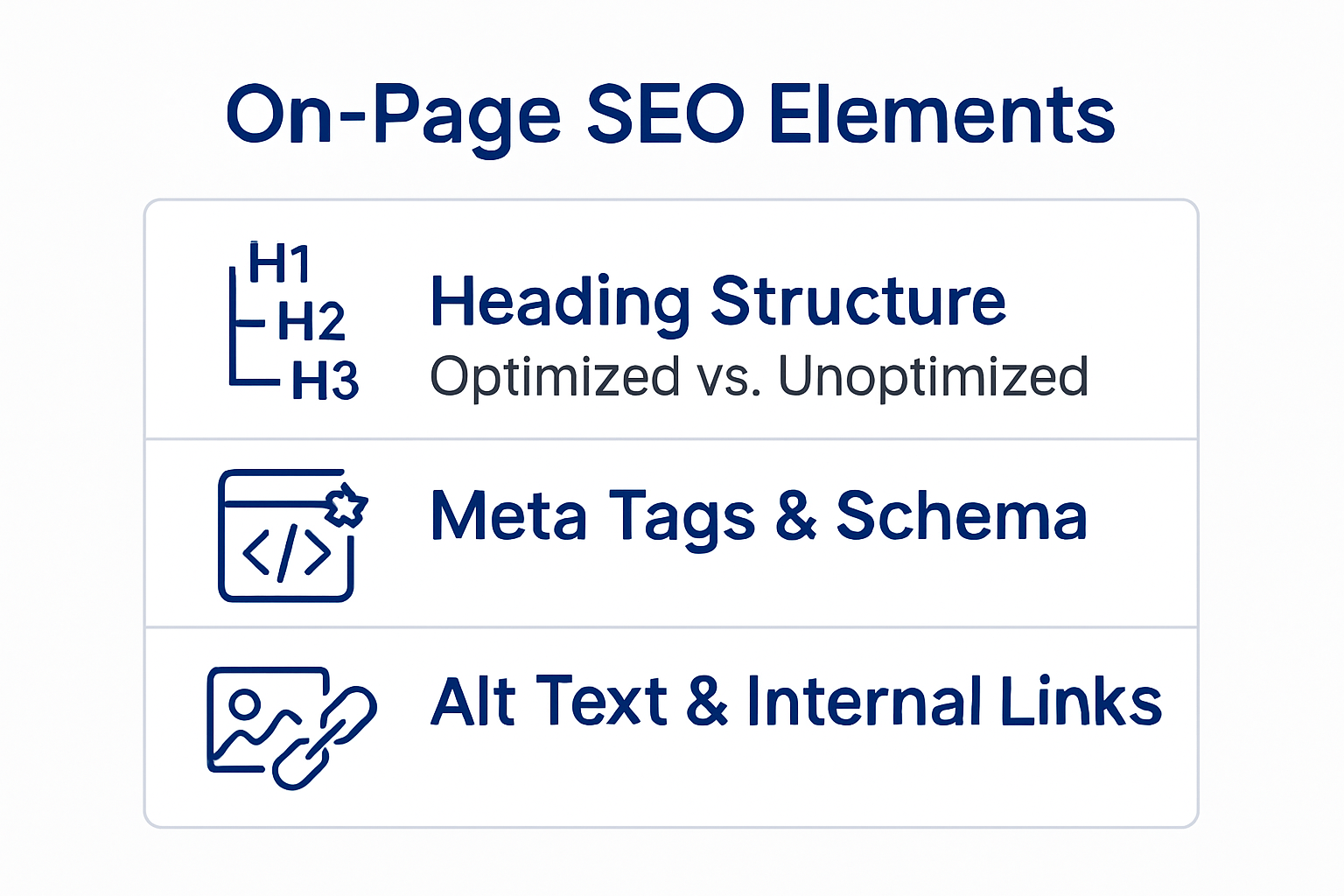Most websites never reach the top search results, and the reasons usually hide deep in technical corners and off-page blind spots. Here’s the shocker. Over 50 percent of all web traffic comes from organic search yet so many sites ignore critical SEO audit steps that decide their fate. The winning edge almost always goes to those who inspect every factor, from site security to high-authority backlinks, before even touching content or keywords.
Table of Contents
- Technical Seo Factors To Check
- On-Page Elements For Higher Visibility
- Off-Page And Backlink Audit Essentials
- Tracking Progress And Setting Priorities
Quick Summary
| Takeaway | Explanation |
|---|---|
| Ensure Website Security with HTTPS | Implement HTTPS using SSL certificates to protect user data and enhance search credibility. |
| Optimize Crawlability with a Sitemap | Create a well-structured sitemap to help search engines efficiently discover and index your site’s pages. |
| Focus on High-Quality Backlinks | Assess backlink quality by domain authority and relevance to enhance your site’s authority and visibility. |
| Prioritize User Experience and Content Quality | Create valuable, engaging content that addresses user intent alongside technical SEO factors. |
| Establish Baseline Metrics for SEO Tracking | Track critical metrics such as organic traffic and keyword rankings to inform ongoing optimization efforts. |
Technical SEO Factors to Check
A comprehensive technical SEO audit goes beyond content and links. These critical backend elements can make or break your website’s search engine performance. Technical optimization ensures search engines can easily crawl, understand, and index your site.
Website Security and Core Infrastructure
Website security is no longer optional. Google recommends that websites implement HTTPS as a standard security protocol. Sites using HTTP risk being marked as ‘not secure’ in browsers, which can significantly harm user trust and search rankings. A secure website uses SSL certificates to encrypt data transmission, protecting both user information and your site’s search credibility.
Key security considerations include:
- SSL Certificate: Ensures encrypted connections
- Secure Server Configuration: Prevents potential vulnerabilities
- Regular Security Updates: Protects against emerging cyber threats
Beyond security, your site’s core technical infrastructure plays a pivotal role in SEO performance. Site speed, mobile responsiveness, and clean code structure directly impact search engine rankings. Slow-loading websites experience higher bounce rates, which search engines interpret as poor user experience.
Crawlability and Indexing Optimization
Search engines rely on sophisticated crawlers to understand and rank website content. Research from Smashing Magazine emphasizes the critical importance of a well-structured sitemap. A comprehensive sitemap acts as a roadmap for web crawlers, helping them efficiently discover and index your website’s pages.
Critical technical elements to audit include:
Here is a summary table of the key technical elements to audit for crawlability and indexing optimization, helping you quickly identify critical areas that require attention during a technical SEO audit.
| Technical Element | Purpose | Best Practice |
|---|---|---|
| Robots.txt File | Guides search engine crawlers | Properly configure to allow/disallow engine access |
| XML Sitemap | Lists all indexable pages | Keep updated, submit to search engines |
| Canonical Tags | Prevents duplicate content issues | Use to indicate preferred version of a page |
| Structured Data Markup | Enhances search result presentation | Implement schema for relevant content types |
- Robots.txt File: Guides search engine crawlers
- XML Sitemap: Provides a complete inventory of indexable pages
- Canonical Tags: Prevent duplicate content issues
- Structured Data Markup: Enhances search result presentation
Website architecture should prioritize clear, logical navigation. Complex site structures with deep, convoluted page hierarchies can confuse search engine crawlers and diminish your site’s ranking potential. Learn more about avoiding content issues that might inadvertently harm your SEO strategy.
Performance and User Experience Signals
Technical SEO isn’t just about backend configurations. It’s fundamentally about creating an exceptional user experience. Google’s algorithms increasingly prioritize websites that deliver fast, responsive, and intuitive interactions.
Key performance metrics to evaluate:
- Page Load Speed: Aim for under 3 seconds
- Mobile Responsiveness: Seamless experience across devices
- Core Web Vitals: Measuring user interaction and visual stability
Regular technical audits help identify and resolve potential barriers that might prevent search engines from properly understanding and ranking your content. By systematically addressing these technical factors, you create a robust foundation for sustainable SEO success.
On-Page Elements for Higher Visibility
On-page SEO elements are the foundational building blocks that determine how search engines understand and rank your content. These critical components go beyond simple keyword placement and require strategic optimization to enhance search visibility.

Content Structure and Header Optimization
Search Engine Journal highlights the critical importance of mobile optimization in modern SEO strategies. Header tags play a crucial role in organizing content and signaling information hierarchy to search engines. According to The Dermatology Authority, proper header tag usage is essential for effective content structuring.
Key header optimization strategies include:
- H1 Tag: Use only one per page, incorporating primary target keyword
- H2 Tags: Break content into logical sections
- H3 Tags: Provide additional content subdivision
- Keyword Placement: Naturally integrate target keywords in headers
Content should follow a logical flow that guides readers through information while maintaining clear semantic structure. Each header should provide a meaningful preview of the content that follows, helping both users and search engine crawlers quickly understand the page’s context.
Metadata and Rich Snippet Optimization
Metadata serves as the first point of interaction between your content and search engine results pages. Title tags and meta descriptions are critical elements that directly influence click-through rates. SEOSLY’s on-page SEO checklist emphasizes the importance of crafting compelling metadata that accurately represents page content.
Essential metadata optimization techniques:
- Title Tags: Limit to 60 characters, include primary keyword
- Meta Descriptions: Craft compelling 155-160 character summaries
- Schema Markup: Implement structured data to enhance rich snippets
- Alt Text: Provide descriptive image annotations
Learn how to prevent content conflicts that might compromise your SEO strategy and dilute page relevance.
User Experience and Content Quality
Modern search algorithms prioritize user experience alongside technical optimization. Content must not only be keyword-rich but also genuinely valuable and engaging. This means creating in-depth, authoritative content that comprehensively addresses user search intent.
Key user experience considerations:
- Content Depth: Provide comprehensive information
- Readability: Use clear, concise language
- Visual Elements: Include relevant images, charts, and graphics
- Internal Linking: Connect related content strategically
Successful on-page optimization requires a holistic approach that balances technical requirements with genuine user value. By meticulously crafting each element of your webpage, you create a powerful signal to search engines about your content’s relevance and quality.
Off-Page and Backlink Audit Essentials
Off-page SEO represents the external factors that influence your website’s search engine rankings. A comprehensive backlink audit is crucial for understanding your site’s authority, identifying potential vulnerabilities, and developing a strategic approach to link building.
Backlink Quality and Authority Assessment
SEO Discovery highlights the significant impact of high-quality backlinks from authoritative domains. Not all backlinks are created equal. Educational (.edu) and government (.gov) domains carry substantial weight in search engine algorithms due to their inherent credibility and trust.
Key elements of backlink quality assessment include:
- Domain Authority: Evaluate linking website’s overall reputation
- Relevance: Ensure links come from contextually related websites
- Link Diversity: Maintain a natural mix of backlink sources
- Anchor Text Distribution: Avoid over-optimized or repetitive anchor texts
A strategic approach involves identifying and cultivating links from reputable sources that genuinely add value to your website’s overall link profile. Learn how to prevent content conflicts that might impact your link-building strategy.
Toxic Link Identification and Removal
Salterra Site provides comprehensive guidance on conducting a thorough backlink audit. Toxic links can severely damage your website’s search engine rankings and credibility. These harmful links often come from low-quality, spammy, or irrelevant websites.
Critical steps in toxic link management:
- Comprehensive Link Audit: Use advanced tools to analyze entire backlink profile
- Spam Score Evaluation: Identify potentially harmful linking domains
- Disavow Process: Formally request search engines to ignore toxic links
- Proactive Link Building: Replace toxic links with high-quality, relevant backlinks
Regular monitoring helps prevent potential penalties and maintains your website’s search engine reputation. Automated tools can assist in identifying and tracking potentially harmful backlinks, but manual review remains crucial.
Strategic Link Acquisition Techniques
Mega SEO offers insights into acquiring high-value backlinks from authoritative domains. Effective link building goes beyond simple quantity and focuses on strategic, meaningful connections.
Advanced link acquisition strategies:
The following table organizes advanced link acquisition strategies mentioned in the article to help you compare and select the methods most suitable for your site’s off-page SEO growth.
| Strategy | Description |
|---|---|
| Guest Blogging | Create valuable content for reputable websites |
| Broken Link Building | Replace defunct links with your content |
| Content Collaboration | Partner with industry experts and influencers |
| Resource Link Building | Develop comprehensive, linkable resources |
- Guest Blogging: Create valuable content for reputable websites
- Broken Link Building: Identify and replace defunct links with your content
- Content Collaboration: Partner with industry experts and influencers
- Resource Link Building: Develop comprehensive, linkable resources
Successful off-page SEO requires a nuanced approach that balances technical optimization with genuine value creation. By carefully curating your backlink profile and focusing on quality over quantity, you can significantly improve your website’s search engine visibility and authority.

Tracking Progress and Setting Priorities
Successful SEO is not a one-time task but a continuous process of measurement, analysis, and strategic improvement. Organic Media Group emphasizes the critical importance of documenting findings and establishing a systematic approach to tracking SEO performance.
Establishing Baseline Metrics and Performance Indicators
Before diving into complex tracking mechanisms, you must establish clear, measurable baseline metrics. These foundational measurements provide a reference point for understanding your website’s current performance and potential growth areas.
Key performance metrics to track include:
- Organic Search Traffic: Total visitors from search engines
- Keyword Rankings: Position for target keywords
- Conversion Rates: Percentage of visitors completing desired actions
- Bounce Rate: Percentage of single-page visits
- Page Load Speed: Technical performance indicator
Smart Insights recommends creating a comprehensive tracking system that goes beyond surface-level metrics. By developing a holistic view of your SEO performance, you can make data-driven decisions that drive meaningful improvements.
Prioritization and Action Planning
Not all SEO improvements are created equal. A strategic approach involves categorizing identified issues based on their potential impact and resource requirements. This method ensures that your team focuses on high-value optimizations that deliver the most significant results.
Prioritization framework:
- High Impact, Low Effort: Immediate implementation
- High Impact, High Effort: Strategic long-term projects
- Low Impact, Low Effort: Quick wins
- Low Impact, High Effort: Potential future considerations
Learn how to prevent content conflicts that might derail your SEO strategy and compromise your optimization efforts.
Regular Reporting and Continuous Improvement
Consistent monitoring and reporting transform SEO from a reactive to a proactive discipline. Develop a reporting cadence that provides stakeholders with clear, actionable insights into your website’s search performance.
Effective reporting strategies:
- Monthly Performance Reviews: Comprehensive analysis
- Quarterly Strategic Adjustments: Realign tactics
- Annual Deep-Dive Audits: Holistic performance evaluation
- Real-Time Dashboard Tracking: Immediate performance insights
Successful SEO is an iterative process that requires patience, strategic thinking, and a commitment to continuous learning. By implementing a robust tracking and prioritization system, you create a framework for sustainable organic growth that adapts to evolving search engine algorithms and user behaviors.
Frequently Asked Questions
What is an SEO audit and why is it important?
An SEO audit is a comprehensive analysis of a website’s performance in terms of search engine optimization. It’s important because it helps identify areas for improvement, ensuring that your site ranks better in search results, attracts organic traffic, and enhances user experience.
What are the key components of a technical SEO audit?
Key components of a technical SEO audit include assessing website security (HTTPS), crawlability and indexing optimization, performance metrics (like page load speed), and user experience signals. Focusing on these elements ensures search engines can properly crawl and index your site.
How can I improve my website’s crawlability?
To improve your website’s crawlability, create a well-structured XML sitemap, ensure your robots.txt file is correctly configured, use canonical tags to avoid duplicate content, and implement structured data markup to enhance content visibility in search results.
What steps should I take for on-page SEO optimization?
For on-page SEO optimization, focus on content structure and header optimization, metadata enhancement (such as title tags and meta descriptions), and ensuring high-quality user experience through engaging and relevant content. These factors help improve search visibility and user engagement.
Is Your SEO Audit Missing the Hidden Threat Holding Back Your Rankings?
You just learned how a thorough SEO audit checklist uncovers technical gaps, on-page weaknesses, and the importance of a strong backlink profile. But most audits overlook one invisible problem that quietly sabotages your rankings: keyword cannibalization. If your own pages are fighting for the same keywords, your hard work on sitemaps or content structure might never pay off. It leads to content conflicts, wasted link equity, and missed opportunities for growth. The difference between good and great SEO often comes down to catching the hidden issues others ignore.
Do not let your site fall behind because of internal competition and overlooked keyword overlap. Use the trusted solution chosen by top SEO consultants and agencies. Run a free check with the #1 Keyword Cannibalization Tool now and turn your audit into a real ranking advantage. If you are ready to see which pages harm your SEO efforts and how to fix them, get started at RankAligner right away. Act before your next audit so search engines reward your improvements instead of burying them.
Recommended
- 15 Winning Hacks to Avoid Keyword Cannibalization Like a Pro
- 10 Keyword Cannibalization Mistakes That Are Killing Your SEO
- The Final Guide to Content Cannibalization in SEO (& How to Avoid)
- How to Exactly Fix Keyword Cannibalization to Improve Website SEO- Rank Aligner
- The Ultimate Website Optimization Checklist for 2025
- Desbloquee el potencial completo del SEO con la IA

